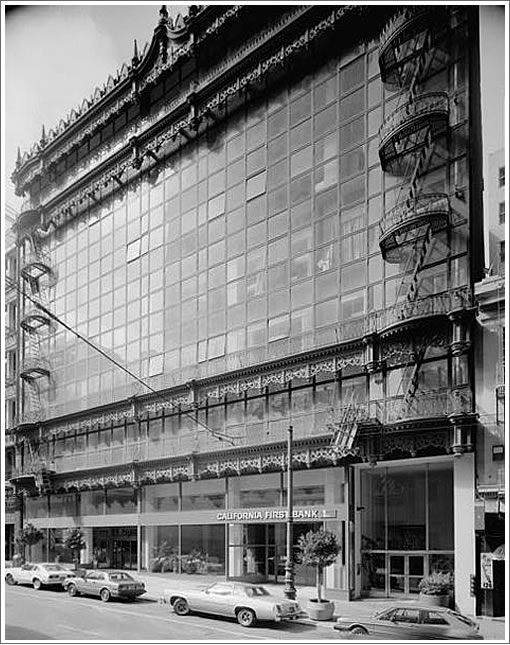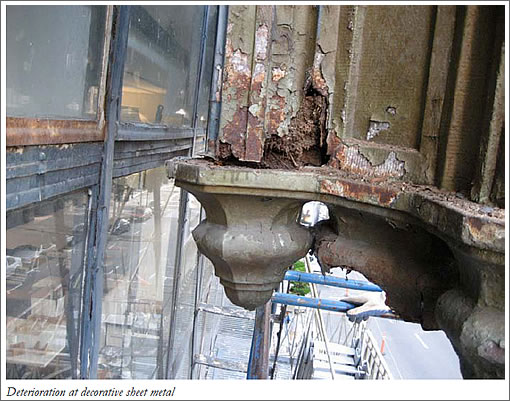
Recent NCAT expert witness reports for the Willis Polk designed Hallidie Building at 130 Sutter Street, San Francisco Landmark number 37 and one of the first examples of glass curtain-walled design:
The purpose of this inspection was to assess the general condition of ornamental metal and their anchorage to the building. We were limited to inspections of the first level of these metal pieces, which are located near the elevation of the second floor. We were assisted in this inspection with the use of a man lift.

Removal of a portion of the metal cladding allowed us to inspect the interior of the metal pieces and thereby we were able to observe the attachment of these pieces to the building structure. The pieces are attached to various steel brackets which are in turn attached to steel out riggers that are an extension of the steel framework of the building. We noted that the steel brackets were not painted with in the concealed space of the metal pieces but were painted where they are exposed to the exterior. We also noted that the roof enclosure over the metal pieces appears to have been leaking for a considerable amount of time.

Of considerable concern is the condition of the steel brackets observed. Pieces of the brackets have deteriorated to the point where they are no longer functional. The steel has completed delaminated and portions of the steel members have disintegrated. It is our opinion that it is just a matter of time before portions of the façade supported by these brackets will fall off of the building.
We strongly recommend that corrective action be taken immediately. Falling protection, some of which we noted has been installed, should be reviewed and complemented if found necessary. Removal of all badly deteriorated elements should begin as soon as possible.
On Wednesday an informational hearing regarding emergency work on the building will be heard by the Historic Preservation Commission as rehabilitation work on the landmark building requires a Certificate of Appropriateness from the Commission.
In the meantime, heads-up.
Some guy in a pickup truck without any fancy advertising should be able to fix this in a flash, without any specialized knowledge of how this building was built or the techniques or materials involved.
What’s the big deal?
This hazard to the public is of tremendous historical significance. I say keep it and set up a CCTV system for observation on the impact of valuable historical artifacts on the general public. (hint: SPLAT!)
It’s just a question of time before the same thing happens to the crumbling Pagoda Theater. Except it’ll mostly be plywood and stucco. A bit less dramatic.
It looks like the contractor cut corners by not painting the “invisible” parts of the structure. Surely even a century ago builders understood that steel will rust if not painted.
This is a historically significant building so fixing the problem is worthwhile. I’m glad that the city was proactive here to inspect and find this problem before someone got clobbered in the sidewalk.
Good for them to detect this early. I can’t wait to see how it looks once they get around to fixing it up in 30 years.
Proactive? LOL! Let’s wait and see how long this will take to actually get fixed. Bureaucracy after bureaucracy after bureaucracy will need to be hurdled over- the materials will have to be just right, a certain color, a specific shape, even a certain weight. We are witnessing “historic preservation” inaction- as we watch our city’s buildings crumble to the ground.
I am not sure how anyone will be able to reproduce the ironwork. Even the Eastern Pan of the Bay Bridge is being constructed out of elements imported from China. This ship has sailed a long time ago.
A better option would be to cast the building in amber. Plenty of that to go around at the historical commission.
I remember thinking the same thing about stone work after the ’89 earthquake, that no one did that kind of work any more. But there are companies that specialize in reconstruction of antique building decor. Prices are not “some guy in a pickup truck” prices, but it can be done. They do an awesome job.
One Market Plaza had a fair amount of facade damage and a restoration company came in, cleaned off the undamaged components to see exactly how they looked and then redid the damaged ones exactly.
In the photo below, some of the curly queues at the bottom of the arches and the decorative elements at the top of the arches had fallen off and the circular inserts between the arches, which are actually a fairly intricate mosaic of color, had cracked. They redid them absolutely perfectly. You can’t tell where old stops and new starts.
http://maps.google.com/maps?q=1+market+street+san+francisco,+ca&oe=utf-8&client=firefox-a&ie=UTF8&hq=&hnear=1+Market+St,+San+Francisco,+California+94105&gl=us&ei=ACX0TMytH4GasAOZyd2aDw&oi=geocode_result&ved=0CBMQ8gEwAA&ll=37.794152,-122.395205&spn=0.014633,0.033023&z=16&layer=c&cbll=37.794154,-122.395207&panoid=tBVKh6b0PIEHRkT0sLGqMQ&cbp=12,135.95,,0,-6.92
The City proactive my foot. The ironwork has been draped in black fabric to catch falling pieces for two years.
The photo in the “Landmark number 37” link above shows the top floors screened off with netting, like someone was doing some work. The photo is from 2008.
Interesting.
I am not sure how anyone will be able to reproduce the ironwork.
This, on a real estate blog?!
I was involved in the restoration of the Sheraton Palace Hotel back in the early ’90’s.
We entirely replaced several of the large round head cast iron door and frame assemblies to undo some earlier bad remodel work. The new work was not in cast iron, but in cast aluminum. Different century, different material.
Rust never sleeps
Just because it’s old, doesn’t mean it’s pretty or significant. Tear it down… it’s hideous and dangerous.
Jimmy – This isn’t just old, it is also significant because it is one of the first examples of curtain wall construction. And though being pretty helps build a case for preservation, aesthetics aren’t the only criteria.
Besides, it is pretty. Except for the ground floor.
Hideous? It’s beautiful. Or, rather, it would be beautiful if the owner fixed the problems and reconstructed the first floor to match its original design.
The City should encourage that sort of preservation with significant tax breaks.
“It’s hideous and dangerous”
“I’m not sure how anyone will be able to reproduce the ironwork”
“Some guy in the pickup truck… will be able to fix this in a flash”
Gosh I love this blog.
“The City should encourage that sort of preservation with significant tax breaks.”
They do. See the Mills Act:
http://ohp.parks.ca.gov/?page_id=21412
As other people in the know mentioned, there are contractors that can do this sort of work, but it’s not cheap. Sucks that they cut corners when putting up this building.
I assume the “some guy in a pickup truck…” comment was a tongue-in-cheek reference to another thread.
Needs bay windows.
what good would bay windows be without some good ol’ california stucco- and plenty of it!
It is crazy to think a building of historic significance, (owned by a local architect, home to the AIA SF and another corporate architecture firm) can fall into such disrepair.
If they can’t maintain their place of occupancy, what makes us believe they can create structures for the rest of us?
I love how the defense of the building is “it’s the first example of..” or “it’s owned by…” or “…designed by…”.
If you built it today, it would be considered hideous… as it is.
Please, let west coast natives start making planning decisions rather than over educated east coast liberal arts majors telling what can and can’t be done.
Remember, nobody wanted the transamerica pyramid build or the embarcadero freeway torn down.
Tear this down and all the normal people in this town will be happy.
I’m sure some of those east coast architect gang will get into it with some west coast architect gang over this building. Watch out for the gun fire. I’d love to know who these “normal people” are.
Jimmy C has a valid point, this building is an eyesore as it sits. But its historical significance is reason alone to preserve the structure.
As far as tearing it down because some people don’t find it a pleasing design or that it’s simply not modern or new enough for them, and using your Embarcadero freeway example:
Firstly, an elevated highway is not the same as a building with unique, historical value and architectural design significance.
Secondly, just because some people don’t like or appreciate something (here the Halladie Building), or that ALL people don’t love it, that does not mean it should be destroyed. To play on that old saying, a historical landmark cannot be all things to all people.
Third, I can cite examples too, where there were people who hated what some people saved.
Remember the cable cars. Many SF residents correctly determined that cable cars outdated and no longer needed. Many said the cable cars were “getting in my way, I have places to go, people to see.”
Now the cable cars are loved by the entire world, a San Francisco icon and one of the biggest San Francisco tourist attractions. (Look up the history of the “save the cable cars” campaign, despite efforts of a few, the entire system was close to total destruction.)
As to solutions for the Halladie Building, there’s plenty of ways to restore it, including fabricating the iron work with modern metals, replacing stone with castings that have a period look.
Example: I ride the California line cable car home every day. It goes past Montgomery and California. At that intersection there was for years a boarded up building, a failed restoration of a 1920s building, for use as modern office space. It never happened, the project a victim of the dot com bust.
Anyway, The Omni Hotel Group fabricated the entire street level facade (three floors) to duplicate the twenties period of the building (and buildings in the “neighborhood”).
Floors 4 and above, the red brick exterior, is all that remains of the original 1920s building. OMNI gutted the entire interior, for the rooms and conference facilities. Some frame iron beams were replaced, but most of the interior frame was kept.
Take a look at this pic to see the kind of work designers and contractors can do, to make a totally new exterior facade look like it’s something from the 1920s to 1930s. Hotel guests have no idea when arriving that the facade is a reproduction.
http://tinyurl.com/OmniSFRestoration
Its sad that such a beautiful building can be neglected like that. Beautiful except for the fire escapes.
The fire escapes are actually considered one of the design elements, as they help to frame the facade, tho of course one could agree with your view that they mar the window wall.
As for the building itself, we’re ~a decade later and I believe it’s still there…so presumably a happy ending.